Micromechanical Numerical Modelling on Compressive Failure of Recycled Concrete using Discrete Element Method (DEM)
Abstract
1. Introduction
2. Experimental Program
2.1. Specimen Preparation
2.2. Nanoindentation Test
2.3. Uniaxial Compression Test and DIC Measurement
3. Numerical Simulation
3.1. DEM and UDEC Program
3.2. Image Based Meso-Structures Model and Microscopic Contact Parameter Determination
4. Numerical Analysis
4.1. Stress–Strain Curve and Contact State Evolvement
4.2. The Complete Failure Processes
4.3. Cracking Modes
5. Parameter Study and Discuss
6. Conclusions
- (1)
- The simulated cracking and failure process of the MRAC specimen shows very similar observations to the experimental results. The proposed numerical model provides the possibility to investigate the failure mechanism of the recycled aggregate concrete at a microscopic level, which is beyond the ability of continuum approaches.
- (2)
- The failure process of the MRAC specimen can be considered as a self-organizing process of microcracks and is dependent on the mesoscopic structure of the specimen. The typical cracking modes controlled by the corresponding mesoscopic structures are concluded according to the numerical observations.
- (3)
- The parameter study shows that the shear strength of the ITZs has a dominant influence on the macroscopic strength of the recycled aggregate concrete, which needs careful consideration in the DEM models.
Author Contributions
Funding
Conflicts of Interest
References
- Tregger, N.; Corr, D.; Graham, L.; Shah, S. Modeling the effect of mesoscale randomness on concrete fracture. Probabilistic Eng. Mech. 2006, 21, 217–225. [Google Scholar] [CrossRef]
- Lilliu, G.; Van Mier, J. On the relative use of micro-mechanical lattice analysis of 3-phase particle composites. Eng. Fract. Mech. 2007, 74, 1174–1189. [Google Scholar] [CrossRef]
- Gonçalves, P.; de Brito, J. Recycled aggregate concrete (RAC)–comparative analysis of existing specifications. Mag. Concr. Res. 2010, 62, 339–346. [Google Scholar] [CrossRef]
- Buyukozturk, O.; Nilson, A.H.; Slate, F.O. Stress-strain response and fracture of a concrete model in biaxial loading. ACI Mater. J. 1971, 68, 590–599. [Google Scholar]
- Choi, S.; Shah, S.P. Propagation of microcracks in concrete studied with subregion scanning computer vision (SSCV). ACI Mater. J. 1999, 96, 255–260. [Google Scholar]
- Li, W.; Xiao, J.; Sun, Z.; Shah, S.P. Failure processes of modeled recycled aggregate concrete under uniaxial compression. Cem. Concr. Compos. 2012, 34, 1149–1158. [Google Scholar] [CrossRef]
- Park, W.-J.; Noguchi, T.; Shin, S.-H.; Oh, D.-Y. Modulus of elasticity of recycled aggregate concrete. Mag. Concr. Res. 2015, 67, 585–591. [Google Scholar] [CrossRef]
- Ren, W.; Yang, Z.-J.; Sharma, R.; Zhang, C.; Withers, P.J. Two-dimensional X-ray CT image based meso-scale fracture modelling of concrete. Eng. Fract. Mech. 2015, 133, 24–39. [Google Scholar] [CrossRef]
- Shang, X.; Yang, J.; Li, J. Fractal characteristics of meso-failure crack in recycled coarse aggregate concrete based on CT image. Acta Mater. Compos. Sin. 2020, 37, 1774–1784. (In Chinese) [Google Scholar] [CrossRef]
- Kim, S.-M.; Abu Al-Rub, R. Meso-scale computational modeling of the plastic-damage response of cementitious composites. Cem. Concr. Res. 2011, 41, 339–358. [Google Scholar] [CrossRef]
- Li, W.; Luo, Z.; Sun, Z.; Hu, Y.; Duan, W. Numerical modelling of plastic–damage response and crack propagation in RAC under uniaxial loading. Mag. Concr. Res. 2018, 70, 459–472. [Google Scholar] [CrossRef]
- López, C.M.; Carol, I.; Aguado, A. Meso-structural study of concrete fracture using interface elements. I: Numerical model and tensile behavior. Mater. Struct. 2007, 41, 583–599. [Google Scholar] [CrossRef]
- Jayasuriya, A.; Adams, M.P.; Bandelt, M.J. Understanding variability in recycled aggregate concrete mechanical properties through numerical simulation and statistical evaluation. Constr. Build. Mater. 2018, 178, 301–312. [Google Scholar] [CrossRef]
- Yang, Z.-J.; Li, B.-B.; Wu, J.-Y. X-ray computed tomography images based phase-field modeling of mesoscopic failure in concrete. Eng. Fract. Mech. 2019, 208, 151–170. [Google Scholar] [CrossRef]
- Yang, X.; You, Z.; Wang, Z.; Dai, Q. Review on heterogeneous model reconstruction of stone-based composites in numerical simulation. Constr. Build. Mater. 2016, 117, 229–243. [Google Scholar] [CrossRef]
- Chen, J.; Jin, X.; Jin, N.; Tian, Y. A nano-model for micromechanics-based elasticity prediction of hardened cement paste. Mag. Concr. Res. 2014, 66, 1145–1153. [Google Scholar] [CrossRef]
- Ghouse, M.D.; Rao, C.L.; Rao, B.N. Numerical Simulation of Fracture Process in Cement Concrete Using Unit Cell Approach. Mech. Adv. Mater. Struct. 2010, 17, 481–487. [Google Scholar] [CrossRef]
- Potyondy, D.; Cundall, P. A bonded-particle model for rock. Int. J. Rock Mech. Min. Sci. 2004, 41, 1329–1364. [Google Scholar] [CrossRef]
- Kazerani, T.; Zhao, J. Micromechanical parameters in bonded particle method for modelling of brittle material failure. Int. J. Numer. Anal. Methods Géoméch 2010, 34, 1877–1895. [Google Scholar] [CrossRef]
- Tan, X.; Konietzky, H. Numerical study of variation in Biot’s coefficient with respect to microstructure of rocks. Tectonophysics 2014, 610, 159–171. [Google Scholar] [CrossRef]
- Tan, X.; Konietzky, H.; Chen, W. Numerical Simulation of Heterogeneous Rock Using Discrete Element Model Based on Digital Image Processing. Rock Mech. Rock Eng. 2016, 49, 4957–4964. [Google Scholar] [CrossRef]
- Tan, X.; Konietzky, H.; Frühwirt, T.; Dan, D.Q. Brazilian Tests on Transversely Isotropic Rocks: Laboratory Testing and Numerical Simulations. Rock Mech. Rock Eng. 2014, 48, 1341–1351. [Google Scholar] [CrossRef]
- Schubert, W.; Khanal, M.; Tomas, J. Impact crushing of particle–particle compounds—experiment and simulation. Int. J. Miner. Process. 2005, 75, 41–52. [Google Scholar] [CrossRef]
- Tan, X.; Li, W.; Zhao, M.; Tam, V.W.Y. Numerical Discrete-Element Method Investigation on Failure Process of Recycled Aggregate Concrete. J. Mater. Civ. Eng. 2019, 31, 04018353. [Google Scholar] [CrossRef]
- Xiao, J.; Li, W.G.; Sun, Z.; Shah, S.P. Crack propagation in recycled aggregate concrete under uniaxial compressive loading. ACI Mater. J. 2012, 109, 451–461. [Google Scholar]
- Yuan, S.; Harrison, J.P. A review of the state of the art in modelling progressive mechanical breakdown and associated fluid flow in intact heterogeneous rocks. Int. J. Rock Mech. Min. Sci. 2006, 43, 1001–1022. [Google Scholar] [CrossRef]
- Xiao, J.; Li, W.; Sun, Z.; Lange, D.A.; Shah, S.P. Properties of interfacial transition zones in recycled aggregate concrete tested by nanoindentation. Cem. Concr. Compos. 2013, 37, 276–292. [Google Scholar] [CrossRef]
- Li, W.; Xiao, J.; Sun, Z.; Kawashima, S.; Shah, S.P. Interfacial transition zones in recycled aggregate concrete with different mixing approaches. Constr. Build. Mater. 2012, 35, 1045–1055. [Google Scholar] [CrossRef]
- Tan, X.; Zhao, M.; Zhu, Z.; Jin, Y. Elastic Properties Calibration Approach for Discrete Element Method Model Based on Voronoi Tessellation Method. Geotech. Geol. Eng. 2018, 37, 2227–2236. [Google Scholar] [CrossRef]
- Igarashi, S.; Bentur, A.; Mindess, S. Microhardness testing of cementitious materials. Adv. Cem. Based Mater. 1996, 4, 48–57. [Google Scholar] [CrossRef]
- Bobko, C.; Ulm, F.-J. The nano-mechanical morphology of shale. Mech. Mater. 2008, 40, 318–337. [Google Scholar] [CrossRef]
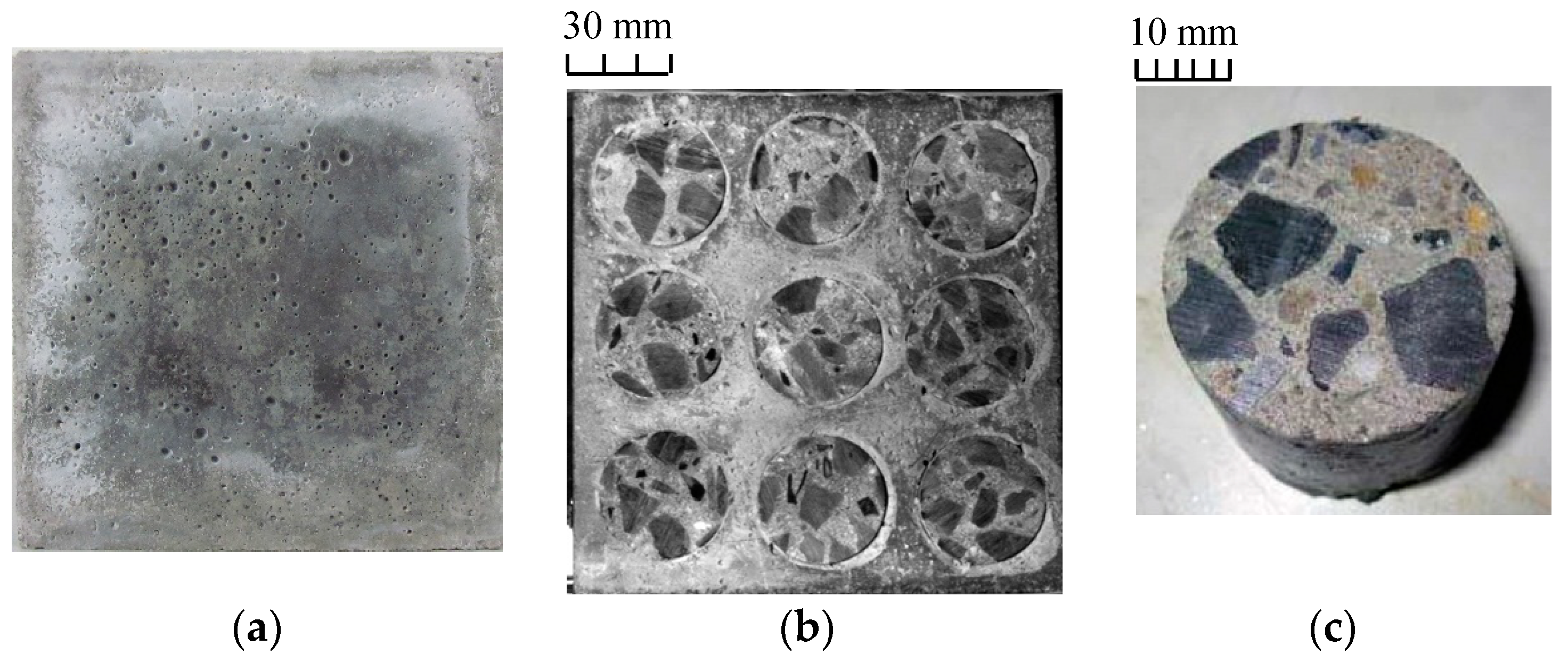

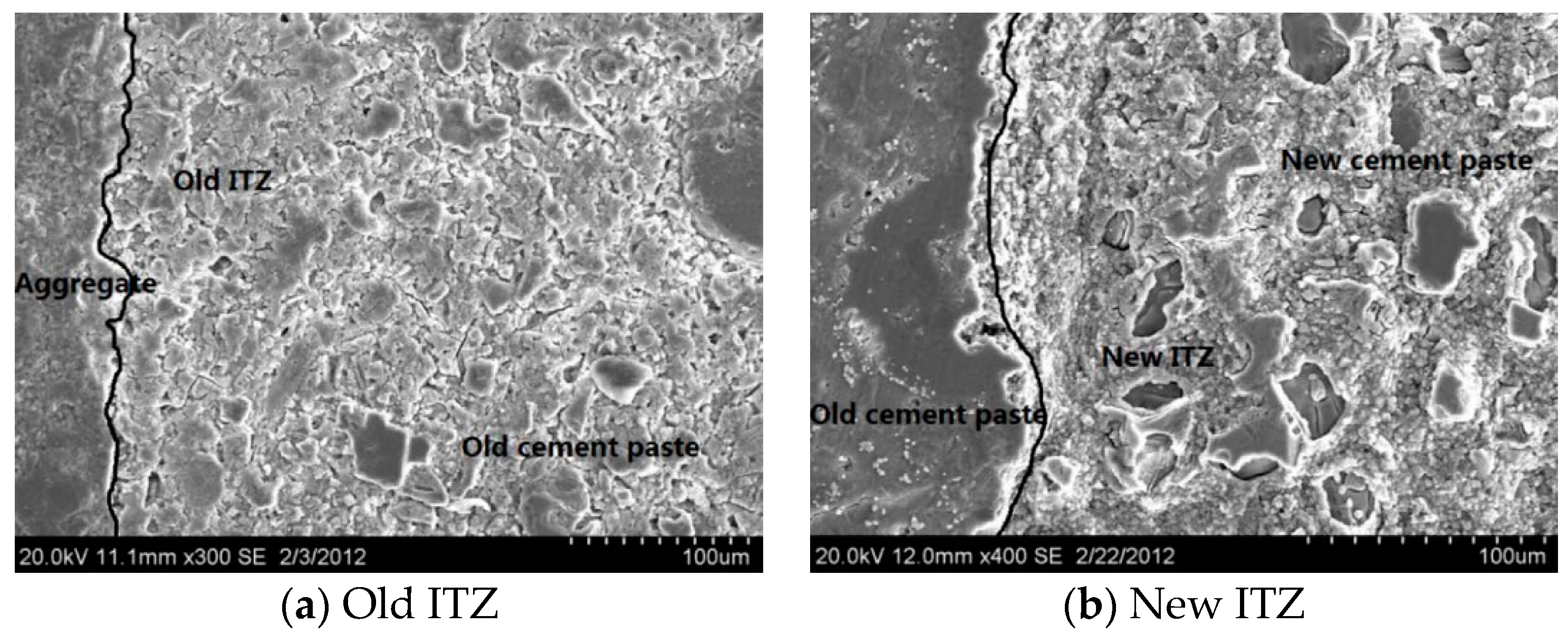
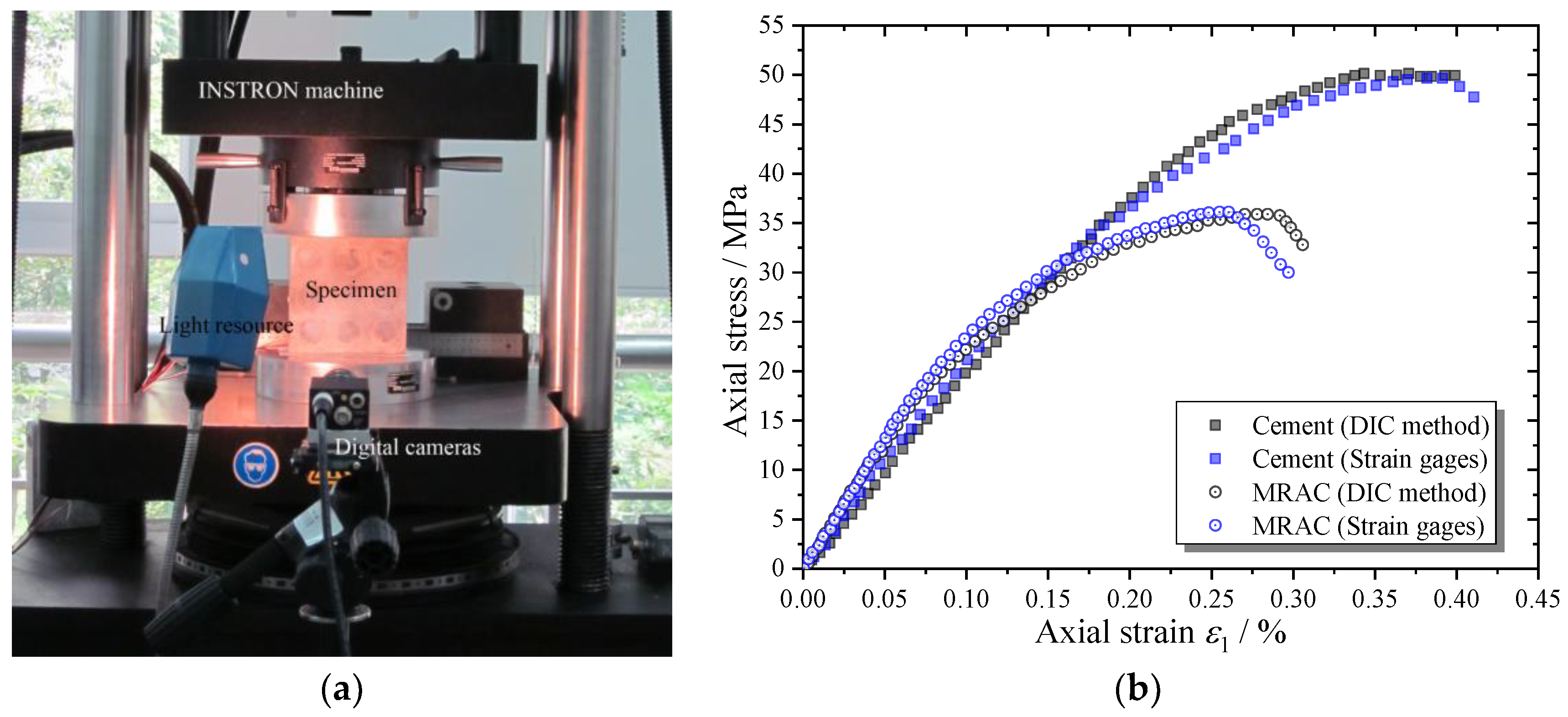
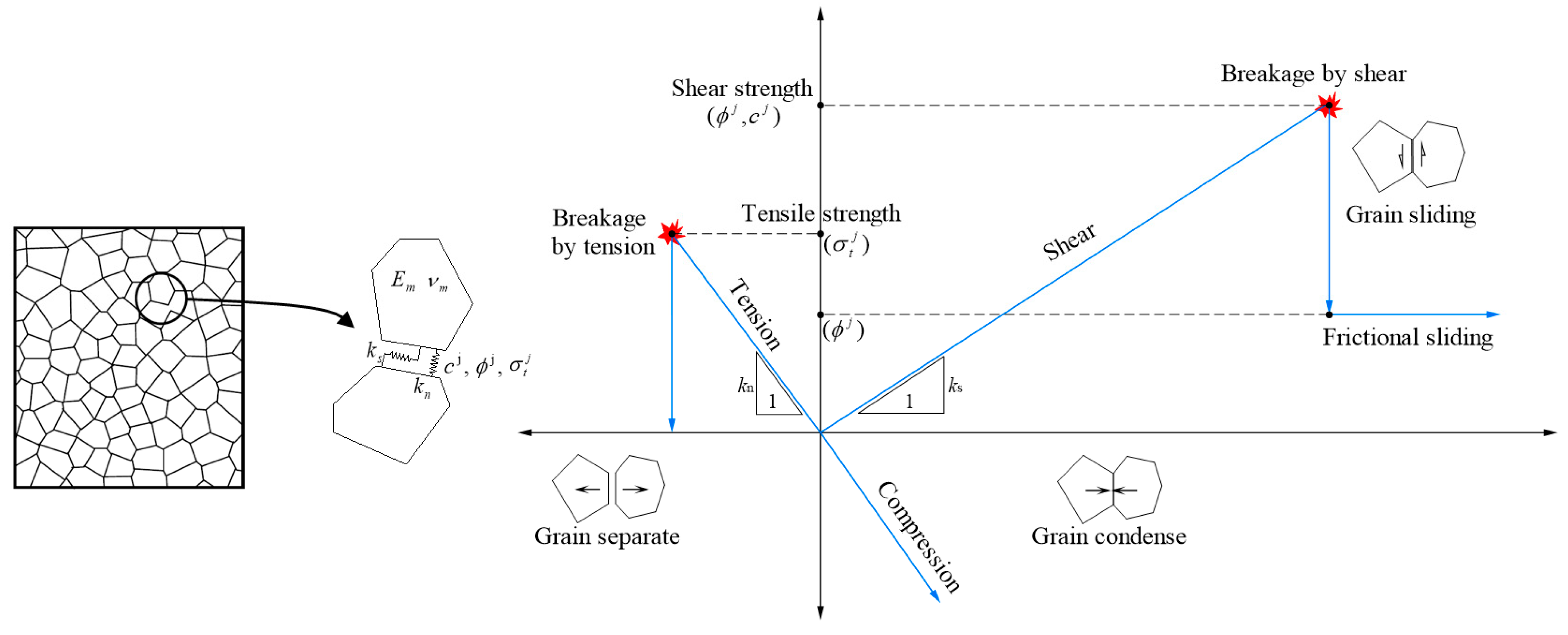


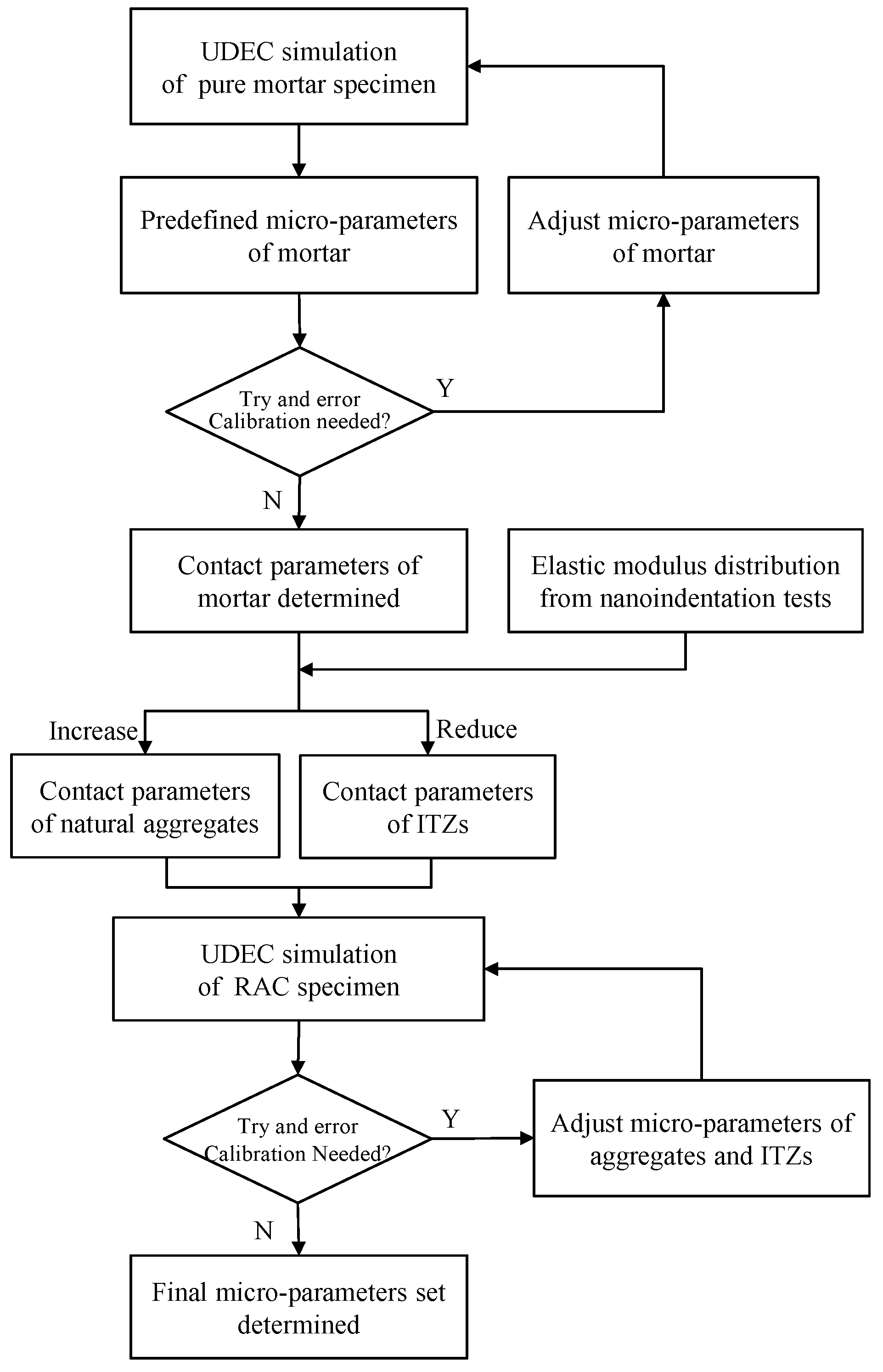

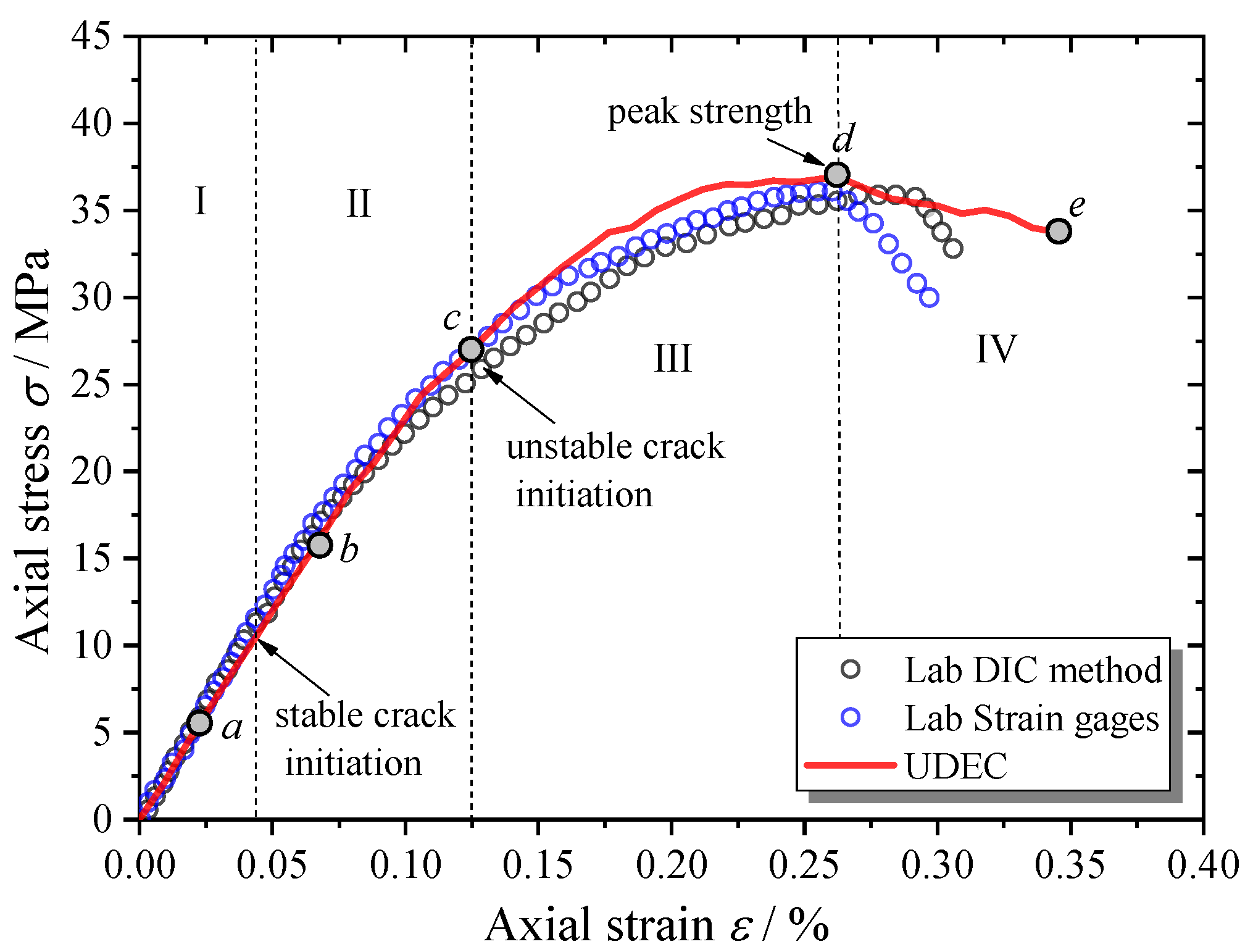

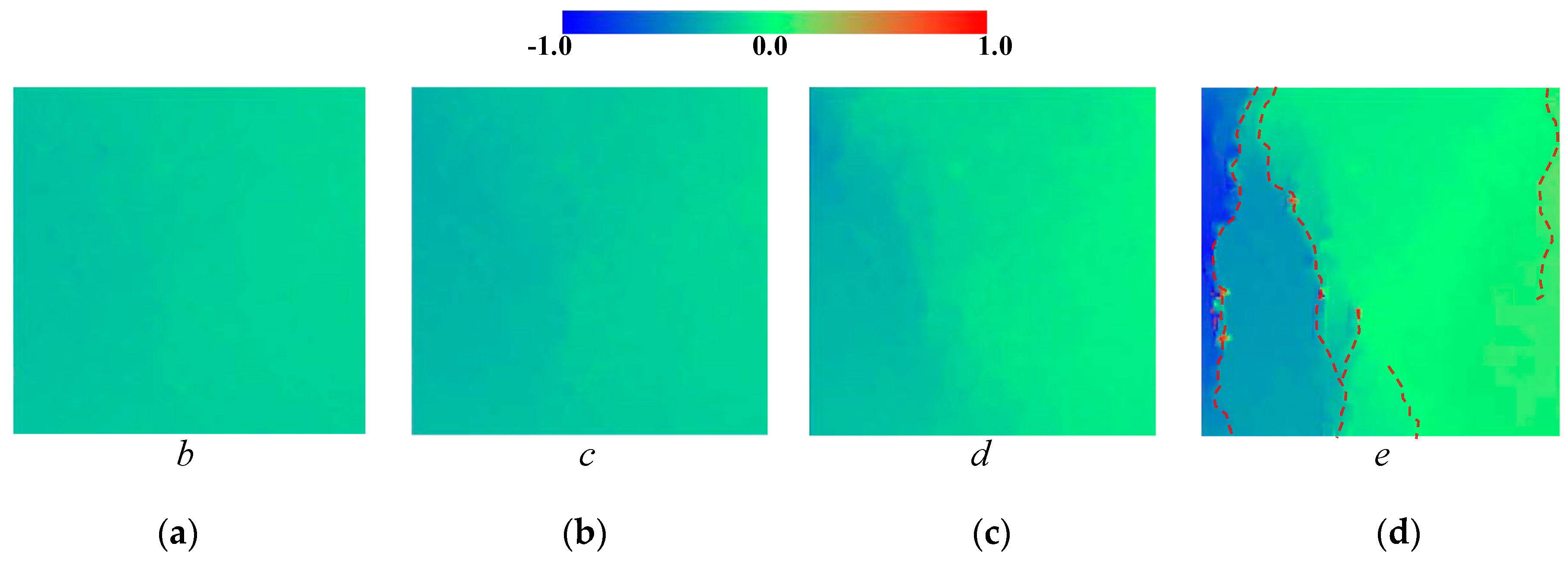
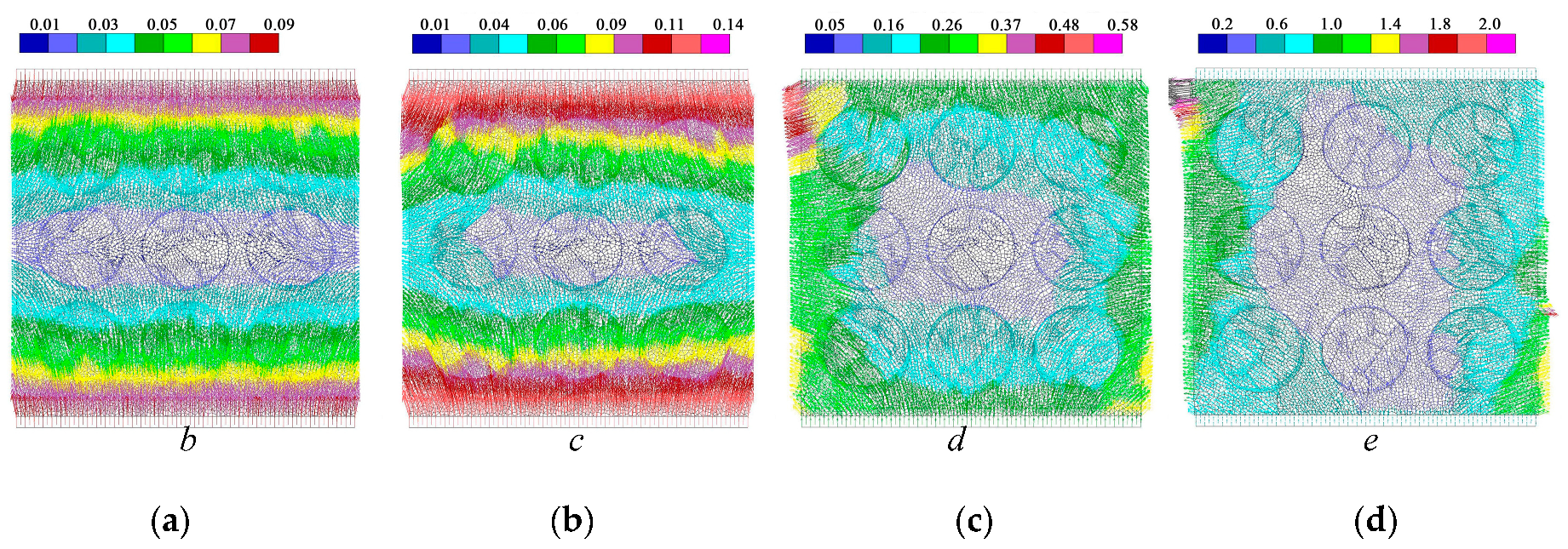
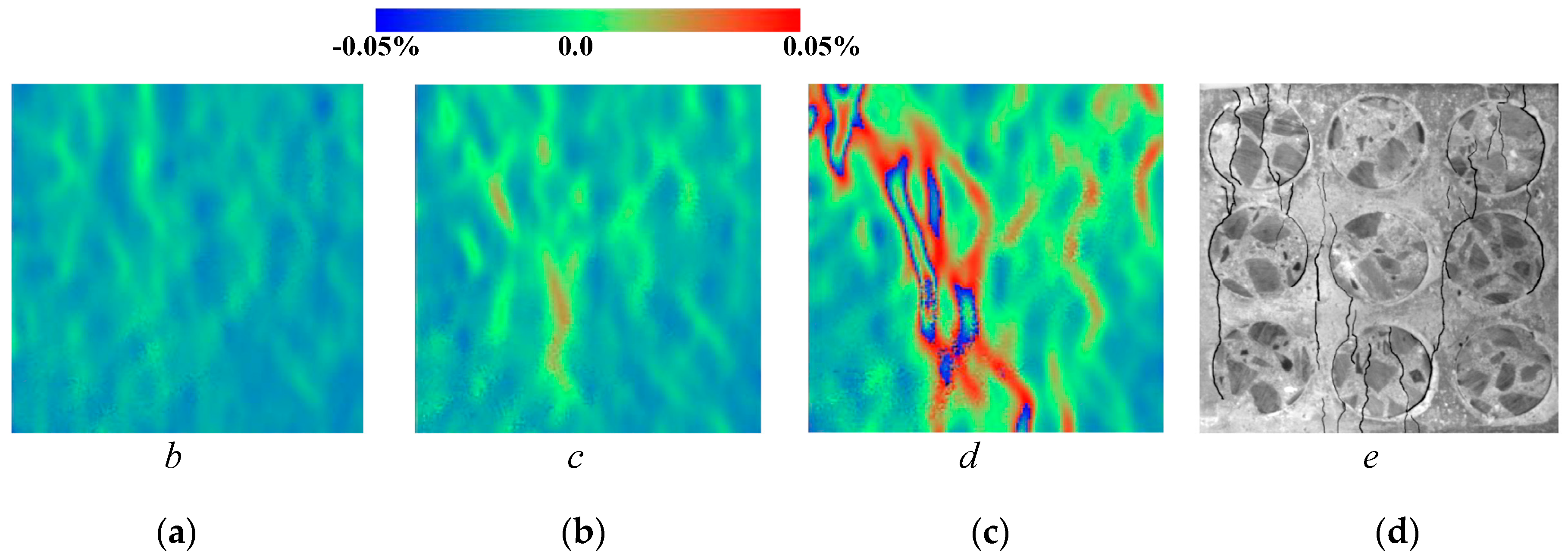
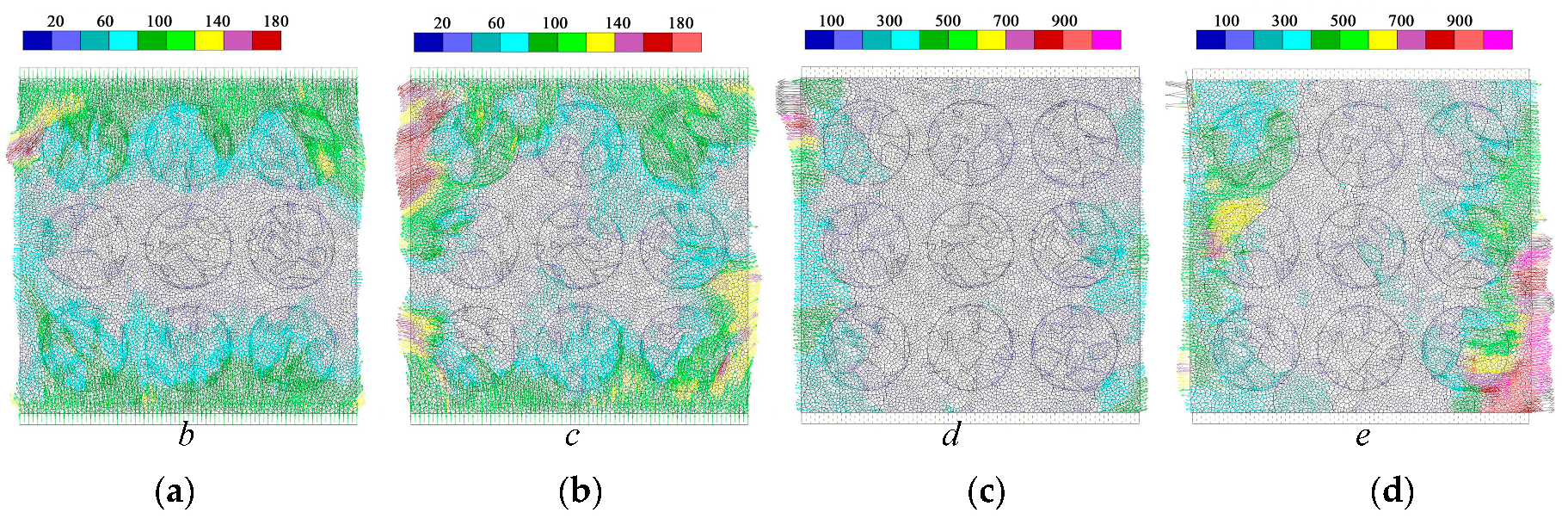





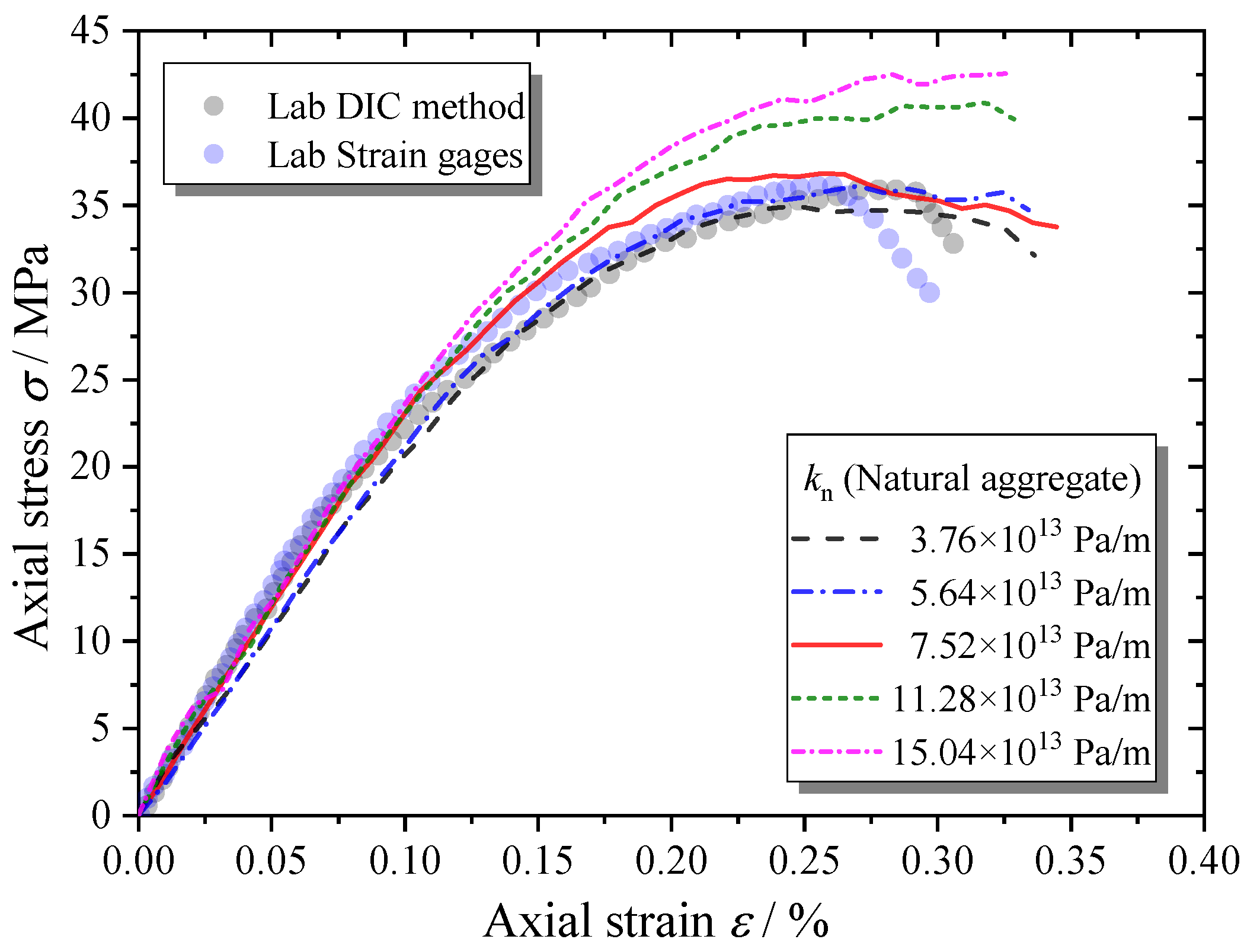
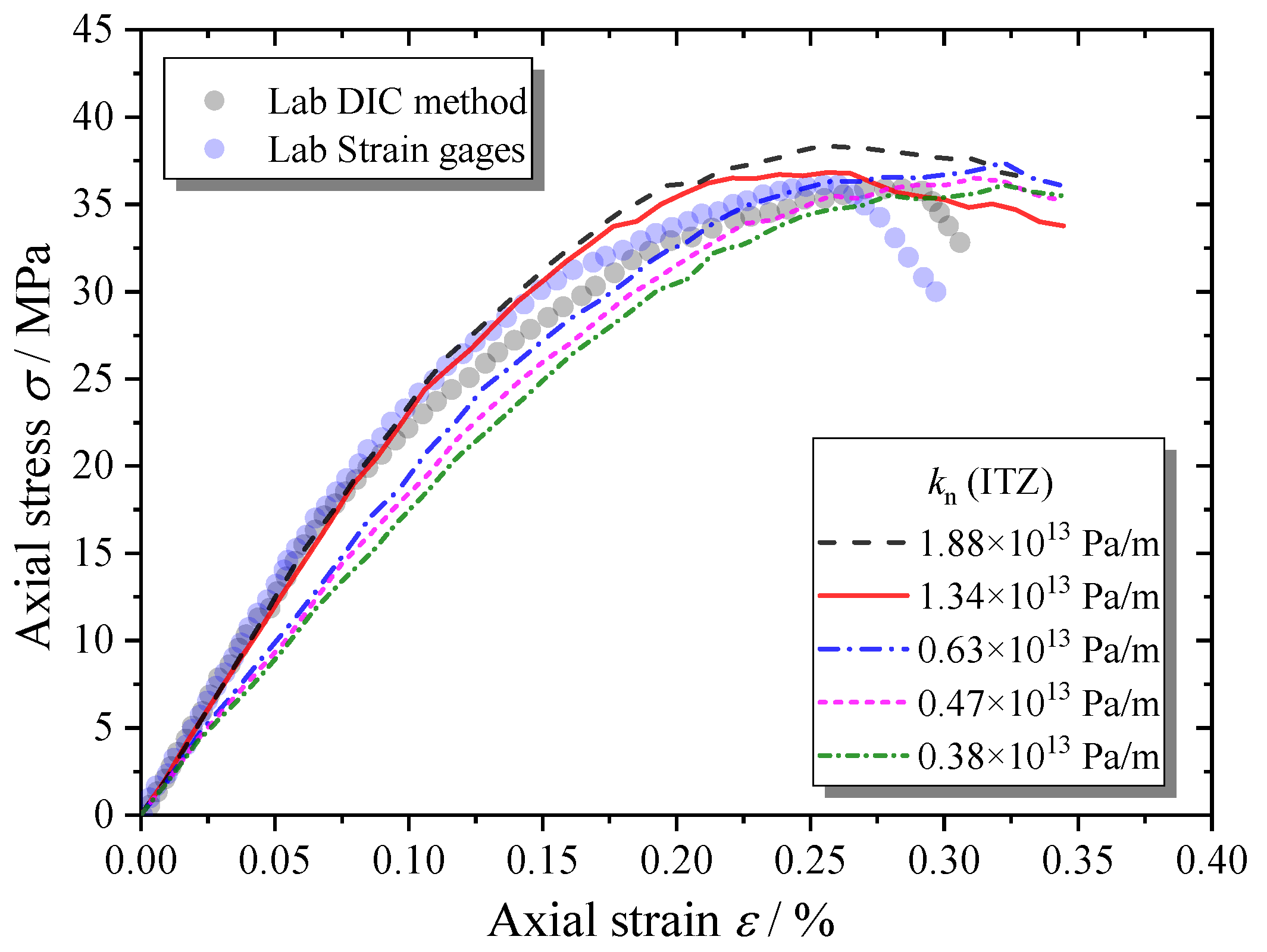
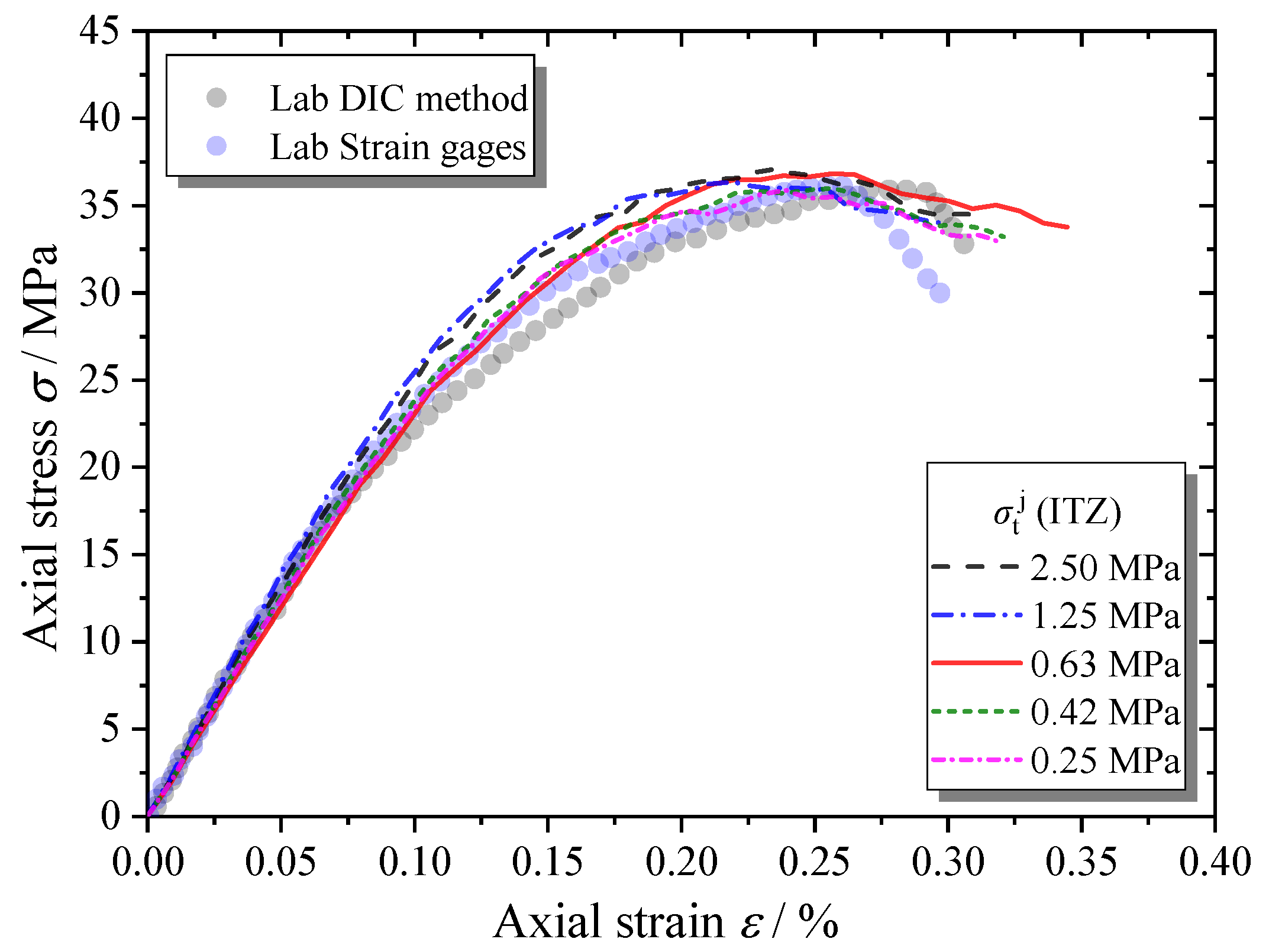
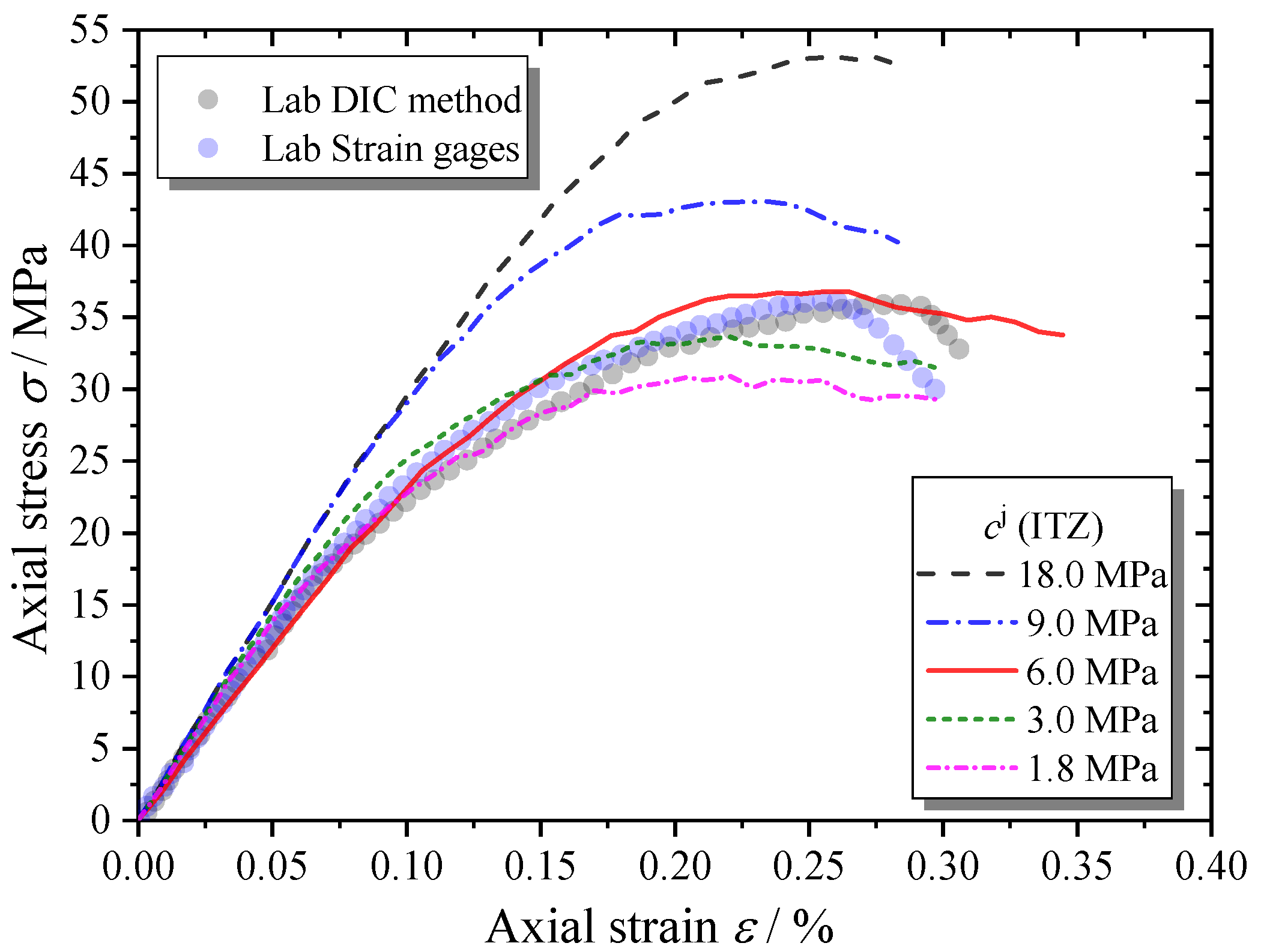
| Material Type | kn | ks | ϕj | cj | σtj | Em | νm |
|---|---|---|---|---|---|---|---|
| Pa/m | ° | MPa | MPa | GPa | / | ||
| Natural aggregate | 7.52 × 1013 | 3.76 × 1013 | 35 | 50.0 | 10.0 | / | |
| Mortar ITZ | 1.68 × 1013 | 9.40 × 1012 | 10 | 18.0 | 2.5 | ||
| 1.34 × 1013 | 3.35 × 1012 | 24 | 6.0 | 0.63 | |||
| Loading plate | 200 | 0.15 | |||||
© 2020 by the authors. Licensee MDPI, Basel, Switzerland. This article is an open access article distributed under the terms and conditions of the Creative Commons Attribution (CC BY) license (http://creativecommons.org/licenses/by/4.0/).
Share and Cite
Tan, X.; Hu, Z.; Li, W.; Zhou, S.; Li, T. Micromechanical Numerical Modelling on Compressive Failure of Recycled Concrete using Discrete Element Method (DEM). Materials 2020, 13, 4329. https://doi.org/10.3390/ma13194329
Tan X, Hu Z, Li W, Zhou S, Li T. Micromechanical Numerical Modelling on Compressive Failure of Recycled Concrete using Discrete Element Method (DEM). Materials. 2020; 13(19):4329. https://doi.org/10.3390/ma13194329
Chicago/Turabian StyleTan, Xin, Zhengbo Hu, Wengui Li, Suhua Zhou, and Tenglong Li. 2020. "Micromechanical Numerical Modelling on Compressive Failure of Recycled Concrete using Discrete Element Method (DEM)" Materials 13, no. 19: 4329. https://doi.org/10.3390/ma13194329
APA StyleTan, X., Hu, Z., Li, W., Zhou, S., & Li, T. (2020). Micromechanical Numerical Modelling on Compressive Failure of Recycled Concrete using Discrete Element Method (DEM). Materials, 13(19), 4329. https://doi.org/10.3390/ma13194329








